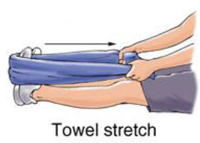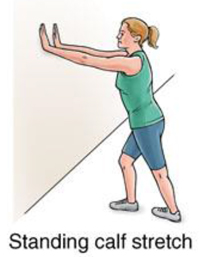Plantar Fasciitis
Plantar Fasciitis Rehabilitation Exercises
You may begin exercising the muscles of your foot right away by gently stretching them as follows:

Prone hip extension:
Lie on your stomach with your legs straight out behind you. Tighten the buttocks and thigh muscles of your injured leg and lift it off the floor about 8 inches. Keep your knee straight. Hold for 5 seconds. Then lower your leg and relax. Do 3 sets of 10.

Towel stretch:
Sit on a hard surface with one leg stretched out in front of you. Loop a towel around your toes and the ball of your foot and pull the towel toward your body keeping your knee straight. Hold this position for 15 to 30 seconds then relax. Repeat 3 times.
When the towel stretch becomes too easy, you may begin doing the standing calf stretch.

Standing calf stretch:
Facing a wall, put your hands against the wall at about eye level. Keep one leg back with the heel on the floor, and the other leg forward. Turn your back foot slightly inward (as if you were pigeon-toed) as you slowly lean into the wall until you feel a stretch in the back of your calf. Hold for 15 to 30 seconds. Repeat 3 times and then switch the position of your legs and repeat the exercise 3 times. Do this exercise several times each day.

Sitting plantar fascia stretch:
Sit in a chair and cross one foot over your other knee. Grab the base of your toes and pull them back toward your leg until you feel a comfortable stretch. Hold 15 seconds and repeat 3 times.
When you can stand comfortably on your injured foot, you can begin standing to stretch the bottom of your foot using the plantar fascia stretch.

Achilles stretch:
Stand with the ball of one foot on a stair. Reach for the bottom step with your heel until you feel a stretch in the arch of your foot. Hold this position for 15 to 30 seconds and then relax. Repeat 3 times.
After you have stretched the bottom muscles of your foot, you can begin strengthening the top muscles of your foot.

Frozen can roll:
Roll your bare injured foot back and forth from your heel to your mid-arch over a frozen juice can. Repeat for 3 to 5 minutes. This exercise is particularly helpful if done first thing in the morning.

Towel pickup:
With your heel on the ground, pick up a towel with your toes. Release. Repeat 10 to 20 times. When this gets easy, add more resistance by placing a book or small weight on the towel.

Balance and reach exercises
Stand upright next to a chair with your injured leg farthest from the chair. This will provide you with support if you need it. Stand just on the foot of your injured leg. Try to raise the arch of this foot while keeping your toes on the floor.
1. Keep your foot in this position and reach forward in front of you with the hand farthest away from the chair, allowing your knee to bend. Repeat this 10 times while maintaining the arch height. This exercise can be made more difficult by reaching farther in front of you. Do 2 sets.

2. Stand in the same position as above. While maintaining your arch height, reach the hand farthest away from the chair across your body toward the chair. The farther you reach, the more challenging the exercise. Do 2 sets of 10.

Heel raise:
Balance yourself while standing behind a chair or counter. Using the chair to help you, raise your body up onto your toes and hold for 5 seconds. Then slowly lower yourself down without holding onto the chair. Hold onto the chair or counter if you need to. When this exercise becomes less painful, try lowering on one leg only. Repeat 10 times. Do 3 sets of 10.

Side-lying leg lift:
Lying on your uninjured side, tighten the front thigh muscles on your top leg and lift that leg 8 to 10 inches away from the other leg. Keep the leg straight and lower slowly. Do 3 sets of 10.
Written by Tammy White, MS, PT, and Phyllis Clapis, PT, DHSc, OCS, for RelayHealth. Published by RelayHealth.
© 2009 RelayHealth and/or its affiliates. All Rights Reserved.


